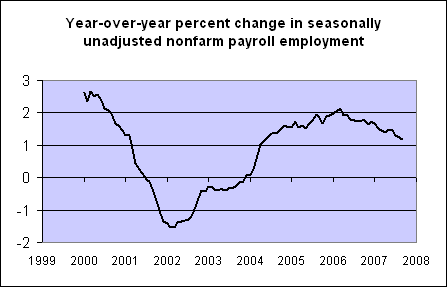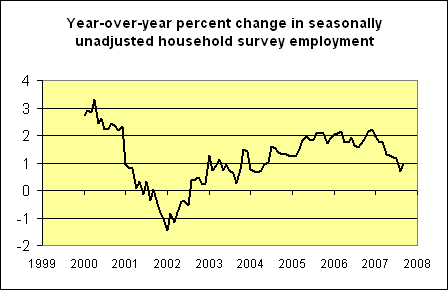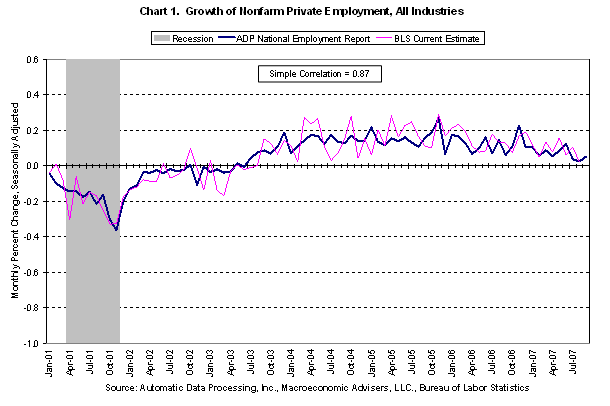As many of us were anticipating, today’s employment data released by the BLS showed substantially stronger job growth for September.
Seasonally adjusted nonfarm payroll employment was reported to have increased by 110,000 net new jobs during September. That’s probably not enough to keep up with population growth, but is substantially better than what you’d expect if we were in the early stages of an economic recession.
But the striking thing about today’s numbers is that the BLS declared the early signals of job loss for August to have been a false alarm. Last month, the BLS had concluded on the basis of their establishment survey that nonfarm payrolls declined by 4,000 jobs in August. Today, they changed their mind, and decided that nonfarm payrolls had actually increased by 89,000 workers in August. And although their separate estimate of August employment based on a survey of households was not revised, the 316,000 loss the BLS says occurred in August was followed, they now say, by a 463,000 gain in September. Go figure.
Perhaps the best you can do with data like these is to try to recognize the longer run trends, by looking at the year-to-year change in the seasonally unadjusted numbers. Such a transformation will leave you a little slow to recognize a turning point, but gives a lot of useful averaging for such noisy data as these. Bad as they are, I believe we can infer from the payroll numbers that job growth is continuing, but at a clearly slower pace than previously.
 |
The BLS household numbers paint the same broad (if even noisier) picture,
 |
as does a separate third measure of private nonfarm employment based on the 23 million payrolls processed by Automatic Data Processing:
 |
All of which suggests an economy that is growing– more slowly than usual, but growing. I remain deeply concerned about what’s ahead for housing and financial stability. But we introduced our Little Econ Watcher as a device for summarizing the broad tendency of recent incoming numbers. As I detailed on Wednesday, the fears I’d had for such sectors as autos, consumption, and employment have not yet been confirmed with hard data. Besides, I’m getting tired of that little frowning face. So for the time being, here’s how I see it: 
Technorati Tags: BLS,
employment
I suppose that this just goes to show that we should never get too excited either way about one month’s worth of data (as if we needed another reminder). And this is another reason to use an average of all the employment indicators, ahough even this is not perfect due to the large swings in the household report.
Nice integration of the data, Professor.
And, I cannot argue with your conclusion to return to ‘even-handed’ emoticon.
Jim-
I was not anticipating the number, but I am not surprised. There is a lot of guess work involved in producing these numbers: missing data, inconsistent data, etc. Finally, I have learned from experience that numbers that are the delta of two big numbers can be off by a lot. With job numbers in the 100K range and total employment in the 145MM range, new jobs are 0.07% of the total. If the beginning or ending number is off by 0.07%, you can have zero jobs added or twice the actual.
Professor,
Today’s speech by the Fed’s Vice Chairman, Donald Kohn, seems to suggest strongly that the Fed would not cut again in October. And this employment report also supports the view they are likely to be more concerned about inflation and dollar’s weakness than the possibility of a recession.
Hey, where’s your weighted average employment growth number. You’re not going to make us do the math ourselves this time, are you?
knzn, actually Ironman has provided a nice tool to do this for all of us. The September calculation comes to +179 thousand new jobs, driven by the very strong household number. Given the huge offsetting negative household number for August, I’m inclined instead at a minimum to take a two-month average, which comes to 93,000 per month. I believe that’s about the right number for the two months, maybe pull August down a little and September up a little from that.
JDH, thanks for noticing! Of course, you’re certainly welcome to the code for that tool if you ever decide to incorporate such things here!
Tedk …
Wrong! Watch what they do, not what they say (the misleading spin they pump out).
At the BB Fed it is the creation of inflation that is “job one.” Inflation creates fear such as the fear of “missing the boat” in housing and the “fear” of holding savings which cannot earn a positive real after-tax return (remember, the American people save too much … NOT) leading to excess consumption in part satisfied by the trade imbalance.
Frankly, I am eagerly anticipating the release of the “minutes” on Tuesday wherein this sorry “gang of twelve” make fools of themselves by expressing some measure of panic over the feared beginning of BB’s dreaded second depression.
When one reads the Kohn speech slowly and word by word one comes to the realization that this is the output of a “Kohn man.”
Spinning like a spinning top.
Was it an intentional oops to give the Fed cover to cut interest rate?
So + or – 100,000 does look a little shaky…why wazit again that we should not expect a similar revision for Aug?
You figure all those job losses in the financial sector are the same sort of jobs that were created in Aug? [Absolutely! New government hires to cope with the glut of regulation needed to sort out the housing boondoggle.]
I’m going to be consistent and wait another month for this Aug “initial” to become “revised”.
Actually, it would look like that if a recession is near. You are looking at intial data, not the more important revised data. I suspect the “whoops” is on the BLS which is to high in some areas.
So the ‘gain’ in Augest may be yet again, wipped away.
I should also add, if you have such large revisions each October, it makes month to month “noise” useless to follow.
If you take out Gov. jobs, private sector growth is only 74k over the last 3 months. Pretty sluggish.
It also confirms my theory the big increase of government jobs over the last 100 years(from less than 10% to 50% in 2005) is the key behind the lack and shallowness of recessions.
This was really no surprise given the high level of corporate profitability.
The talk of recession was always overblown while profits remained so strong.
After all capitalism is a system which rests on profits. If profits are high – output expands – demand is created (profits, rents, wages etc.) – and the economy grows.
Demand expands as a consequence of increases in production – not the other way around, provided profits are rising, adequate demand will be created to realise it. Say’s Law did have a rational basis after all – in fact it was little more than a common place at the time – where it was wrong was in assuming the identity of production and sale, which are two separate moments in the capitalist production process.
Something which Keynes rediscovered 50 years after Marx had pointed it out.
bill, I don’t agree. Corporate profits fell in the late 90’s badly but the ensuing recession was weak.
It is all about consumer spending now and the impact on retail/luxery style jobs. If it continues its decline over the coming quarters, we have a problem that would take all those “corporate profits” and throw them to the wind.
As you say at the end of the 1990s corporate profits fell before the recession – which was a consequence of their decline.
The subsequent boom, the strongest five year series of growth since the 1960s worldwide, is a result of profit rates recovering close to or past the levels of the post war boom.
As profits have risen – production has expanded and demand risen alongside it.
Why was the recession so weak after the collapse of the Hi-Tech bubble, the second biggest stock market fall in history? Because world profitability had risen with the integration of the formally centrally planned economies of the USSR, China etc. and the transformation into capitalist economies.
There does indeed to be a pretty regular 10 year business cycle, which if the pattern holds would reach its end in the early years of the next decade.
What’s interesting about this mid-cycle slow down is how weak it is. Implying once again that world profitability has indeed recovered to very high levels.
Could be I smothered HZ’s somewhat cynical? comment:
Or healthy skepticism that invites us to mull over the size of these revisions with the (merely?) coincident size of adjustment to the interest rate.
Few would argue that these interest rates have this immediate an effect on our economy…until you realize that so much of it is Financial and that it was minutes, if not seconds, for the market to respond. But the effects on the rest are infamously “long and lagging”.
No, the real worry is that the pretext for a rate drop was manufactured by posting deliberately low “initial” guesses for job creation (as if the Fed cares about labor and those stagnant wages)[You figure this is real cynicism?] making the charge that this is/was a deplorable rescue of those Investment Banks…a little harder to support…but not for GM workers …who are just bitter…not like steely GM executives…who think that fx can cover for their incompetence…atleast until they get their bonuses.
You figure that was too cynical? cynical cynicism undermining the genuine case? [Are you competent enough to mull it over by yerself or do you need constant prodding? Hope so.]
The jobs report was pretty weak. Not enough new jobs to hold down unemployment. Manufacturing and construction down again, the growth was mostly in government jobs, and low paying jobs.
Despite the stock market rally, the jobs report was not good.
And revolving consumer credit (credit cards) is now growing a a rapid pace again, presumably because HELOCs are no longer available. This story has a very unhappy ending.
I have no trouble with the analysis of the data here, but I’m less convinced by the implication drawn that recession is far away. A look at the graphs provided shows that employment bottoms after recessions. Employment growth tends to slow, y/y, before recessions, but not to go negative until recessions begin. Employment growth is slowing, y/y. How does that given any sign that recession is not near? At best, the revision gives a better look to consumer spending, but private hiring doesn’t look any better than was expected ahead of the data.
(Forecasts for ADP private hiring were in the 50k-60k range for September. That is what we got. Estimates for overall Sepember hiring were near the result, so no surprises, overall, in September. Most of the revisions were to public sector hiring. Thus, private hiring looks not better than expected.)
How much of this August/ September swing reflects new teacher hiring? Most districts wait for a while to report new hires, if not make those hires at the last second, and I’m wondering if that’s a big reason behind the huge August revision up.
As others note, a lot of this is government hiring, and even at 100,000 jobs, it’s not keeping up with the growth in the workforce, which I generally see estimated at 125-150K a month. Not recession territory, but starting to deteriorate.
Sounds all pretty fishy to me. Is there any reason to believe that these figures are not politically manipulated?
How much of this August/ September swing reflects new teacher hiring?
You’re correct, that’s the vast majority of the August revision, as some stories on the report indicated. The old August numbers reflected an unusually large year-to-year decline in the number of local school employees, which was entirely reversed in the latest numbers. The old numbers were particularly suspect, as it seemed unlikely that school districts had laid off that many employees; rather, it was more likely that a significant number of school districts reported their hires late in August or started school late this year.